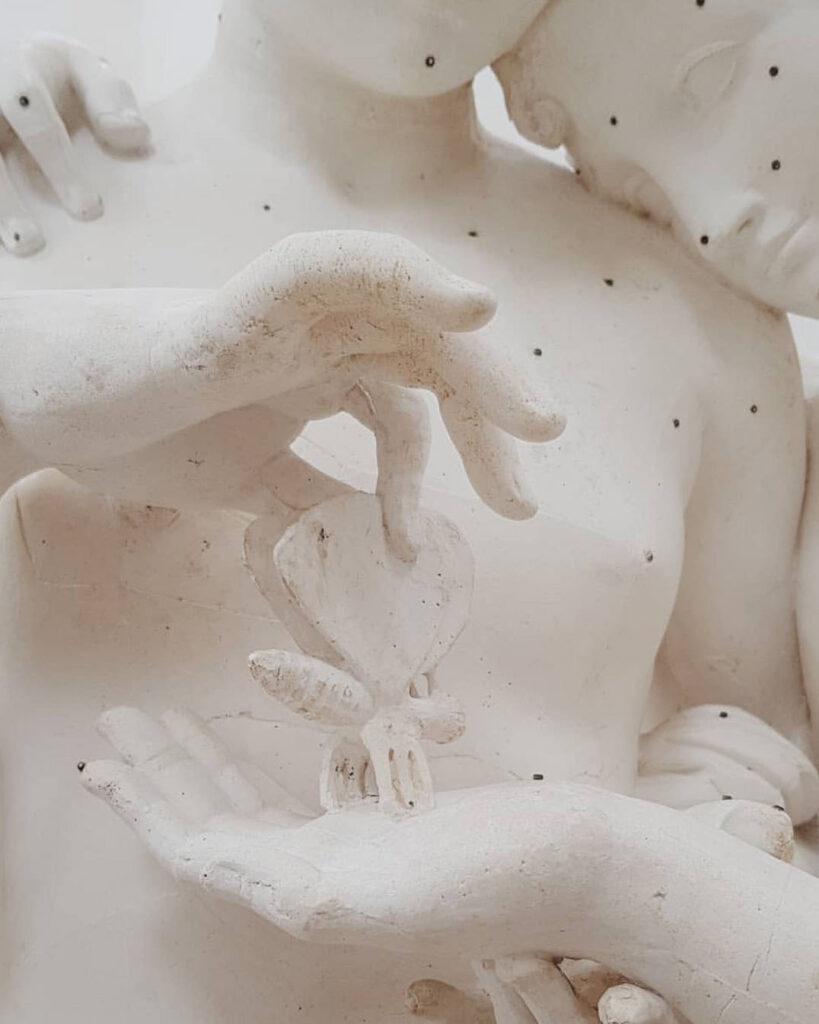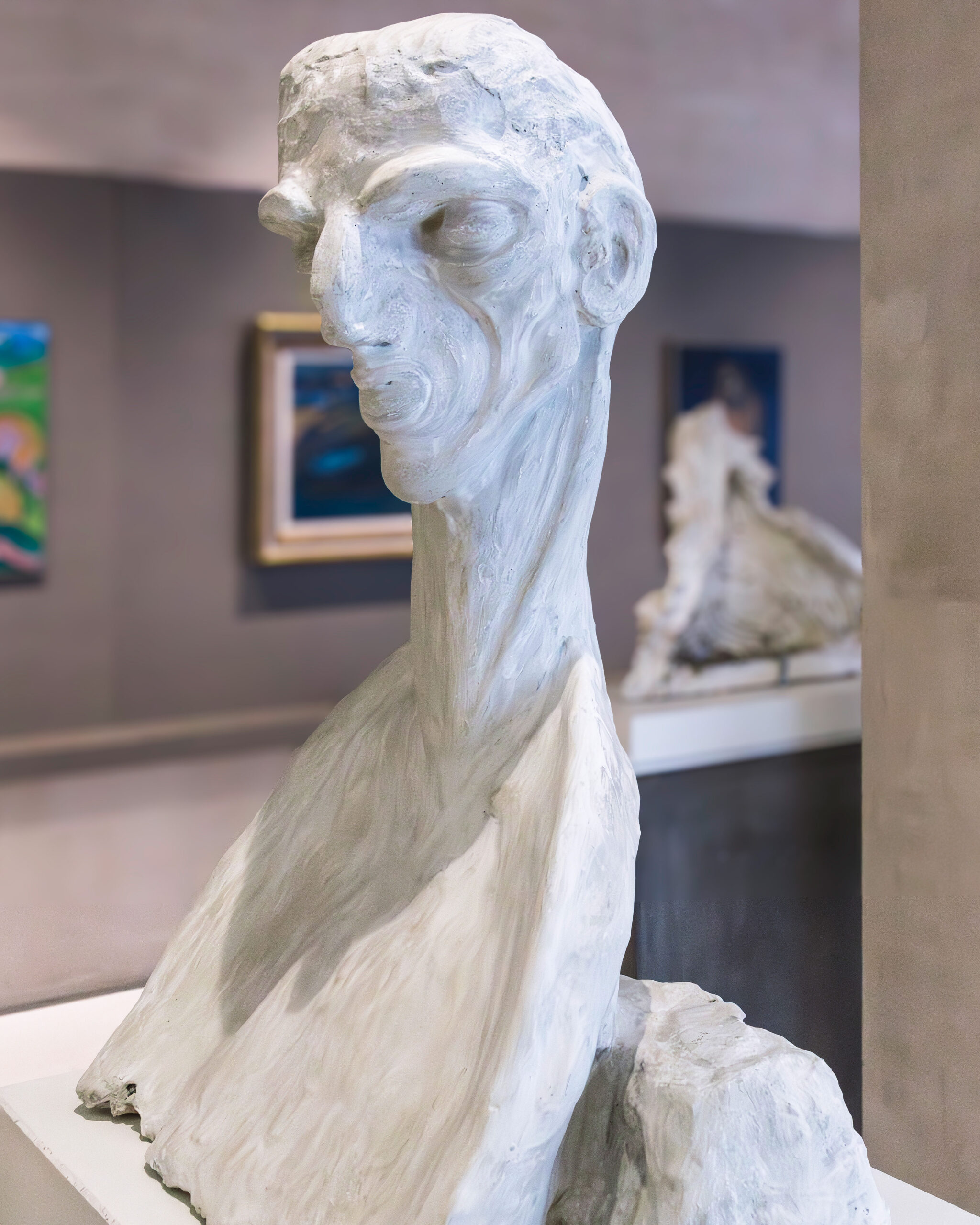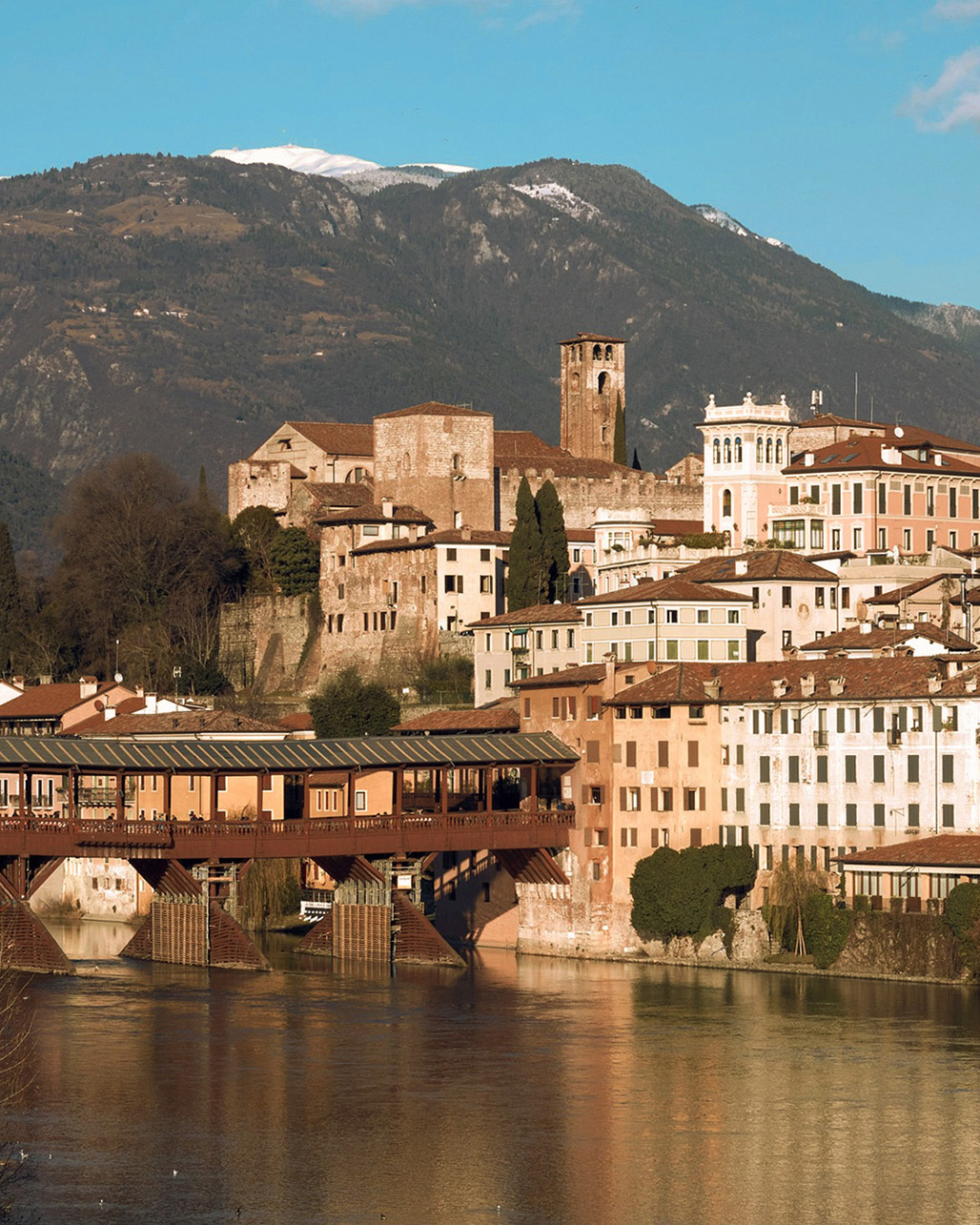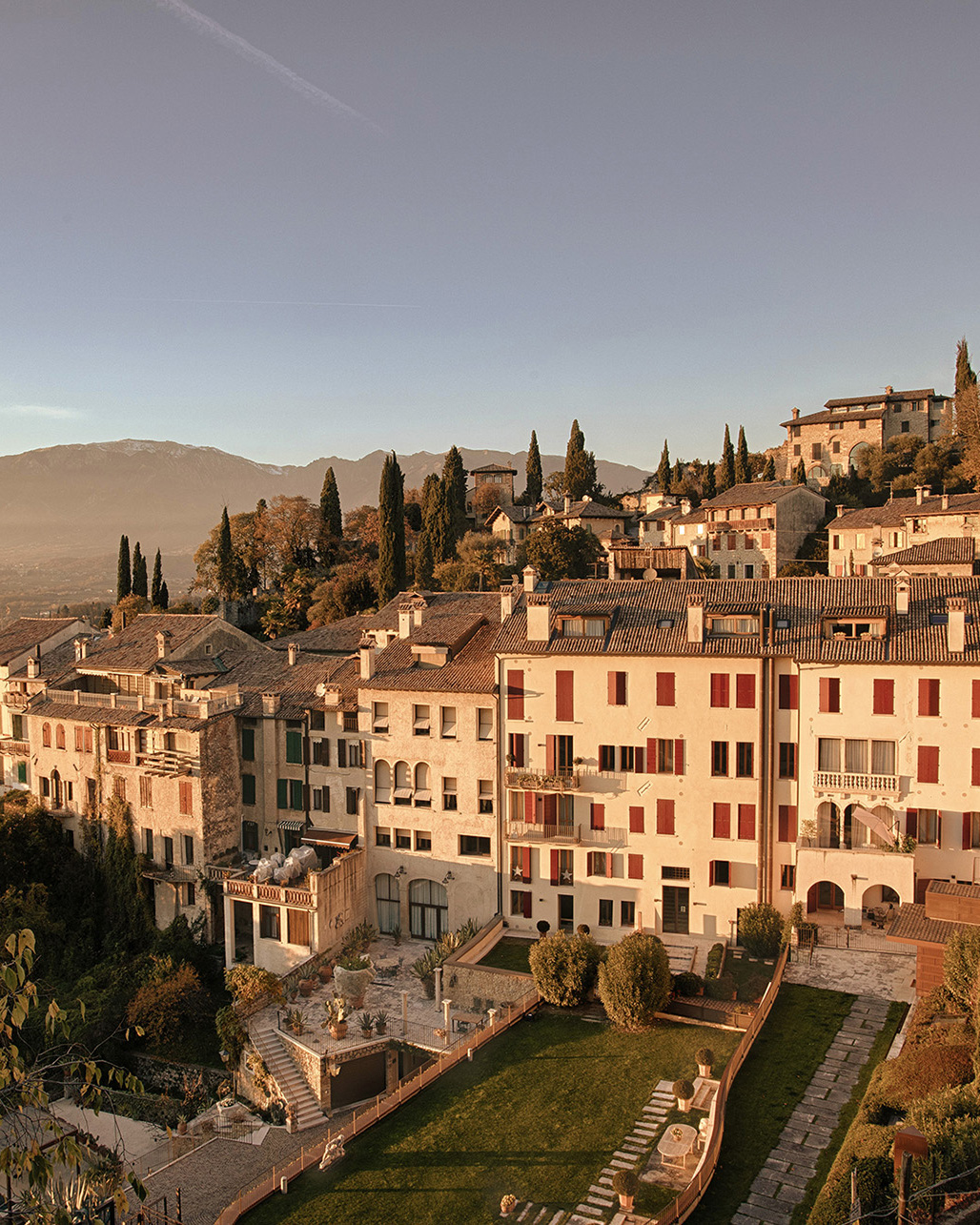The ideal starting point to explore the territory through art, architecture, and nature. Relaxing walks and cultural itineraries offer ever-new insights, with easily accessible cities of art. The property is located at the center of 9 UNESCO World Heritage sites, a unique area in Italy and the world, less than 100 km from the Dolomites.
The Castelletto is immersed in the vibrant entrepreneurial, creative, and industrial fabric of the Northeast. Thanks to its strategic location, just a few kilometers from two international airports, it is possible to reach in about an hour the main cities and industrial hubs of the area, including Verona, Vicenza, Padua, and Venice.


Montebelluna, a few kilometers from Treviso, occupies a strategic location at the foot of the Prosecco hills, with the Pre-Alps as a backdrop and quick connections to Venice and the Dolomites.
The city is internationally famous for its footwear district, recognized as one of Italy's leading sports footwear hubs. The industrial fabric includes hundreds of companies that combine historical experience, technological research and innovation.
Alongside its industrial vocation, Montebelluna is immersed in a wine-growing area of excellence. On the surrounding hillsides ripen the grapes of Prosecco DOC and DOCG, appreciated worldwide. The city fits into a landscape that combines quality agricultural production and industrial innovation, an example of the balance between work, tradition and territory.
A UNESCO World Heritage site and symbol of the Italian Alps, the Dolomites stand out for their spectacular light-colored peaks that glow pink at sunset in the phenomenon known as “enrosadira.” This extraordinary natural landscape is made up of valleys, alpine lakes, and small villages, where Ladin, Venetian, and Tyrolean cultures and traditions intertwine. An ideal destination for hiking, winter sports, and moments of relaxation in nature, the Dolomites offer unique and some of the most breathtaking sceneries in the world.
From Montebelluna, the Belluno Dolomites National Park and alpine and pre-alpine locations such as Asiago, Feltre, or Fiera di Primiero can be reached in about an hour by car, while destinations like Cortina d'Ampezzo and San Martino di Castrozza require about two hours.
Alternatively, a direct train connection reaches Belluno, from where buses depart to the main Dolomite destinations.


A UNESCO World Heritage site and symbol of the Italian Alps, the Dolomites stand out for their spectacular light-colored peaks that glow pink at sunset in the phenomenon known as “enrosadira.” This extraordinary natural landscape is made up of valleys, alpine lakes, and small villages, where Ladin, Venetian, and Tyrolean cultures and traditions intertwine. An ideal destination for hiking, winter sports, and moments of relaxation in nature, the Dolomites offer unique and some of the most breathtaking sceneries in the world.
From Montebelluna, the Belluno Dolomites National Park and alpine and pre-alpine locations such as Asiago, Feltre, or Fiera di Primiero can be reached in about an hour by car, while destinations like Cortina d'Ampezzo and San Martino di Castrozza require about two hours.
Alternatively, a direct train connection reaches Belluno, from where buses depart to the main Dolomite destinations.

A unique city in the world, Venice was founded in the 5th century on the islands of the lagoon as a refuge from invaders and soon became a leading maritime and commercial power. Its history is marked by Byzantine, Arab, and Renaissance influences that have enriched its art, architecture, and traditions. Today, the city is a UNESCO World Heritage site, famous for Piazza San Marco with its Basilica and Campanile, the Doge's Palace, the Rialto Bridge, and the Grand Canal, as well as its authentic neighborhoods like Cannaregio and Dorsoduro.
From Montebelluna, Venice can be reached in about 1 hour by car, taking the A27 to Mestre and continuing on the Ponte della Libertà, or in about 1 hour and 15 minutes by train with a change in Treviso or Castelfranco Veneto to the Venezia Santa Lucia station.
The Prosecco Hills, a UNESCO World Heritage site, extend between Valdobbiadene, Conegliano, and Asolo, embracing the territory of Montebelluna in a harmonious landscape of vineyards and villages. Here, viticulture is part of the local culture and identity: an ancient knowledge that combines technique, dedication, and respect for the land.
In this context lies our production area, which belongs to the Asolo Montello Consortium, where Prosecco finds one of its most elegant and authentic expressions. Among ancient cellars and contemporary producers, each hill tells a different way of interpreting the Veneto's symbolic wine, now known and appreciated worldwide. A territory that invites discovery through tastings, scenic routes, and traditions.


The Prosecco Hills, a UNESCO World Heritage site, extend between Valdobbiadene, Conegliano, and Asolo, embracing the territory of Montebelluna in a harmonious landscape of vineyards and villages. Here, viticulture is part of the local culture and identity: an ancient knowledge that combines technique, dedication, and respect for the land.
In this context lies our production area, which belongs to the Asolo Montello Consortium, where Prosecco finds one of its most elegant and authentic expressions. Among ancient cellars and contemporary producers, each hill tells a different way of interpreting the Veneto's symbolic wine, now known and appreciated worldwide. A territory that invites discovery through tastings, scenic routes, and traditions.
Just steps from the hotel is our Ager Patris estate, a green oasis in the heart of Montebelluna. During the renovation works, pre-Roman and Roman artifacts were discovered, attesting to the site's long history. Today, the estate spans four hectares of organic vineyard, surrounded by a path immersed among olive trees, with scattered cypress trees creating pleasant shaded spots and pauses, ideal for walking and rejuvenating in the greenery.
The harvest is manual and respects the optimal ripening of the grapes, ensuring quality organic wines, available for purchase and tasting by guests. The wines are also available in the Ager Patris Lounge, on the ground floor of the Atrium, to savor comfortably during the stay.
Visit the Ager Patris website to learn more about our wines and our story.


The Gypsotheca in Possagno houses an important collection of plaster casts and sculptures by Antonio Canova, one of the most celebrated Neoclassical sculptors. Located in his hometown, it preserves the plaster models used by the artist for his most famous works, offering a fascinating journey through his art and legacy.

13 km
15 minutes by car
The Brion Memorial, in San Vito di Altivole, is a funerary monument designed by Carlo Scarpa between 1970 and 1978 for the Brion family. Considered one of the masterpieces of 20th-century architecture, it combines modern design and symbolism within a garden inspired by Eastern models. Open to the public, it is now a FAI heritage site.

9 km
15 minutes by car
Villa Barbaro in Maser, a masterpiece by Andrea Palladio, is an elegant 16th-century Venetian villa set amidst the hills of Treviso. It stands out for its refined classical architecture and the exquisite frescoes by Paolo Veronese, enhanced by elements inspired by ancient Rome. A symbol of beauty and culture, it is a UNESCO World Heritage site.

BAILO MUSEUM.
Treviso
20 km
20 minutes by car
The Bailo Museum, in Treviso, is housed in a former Augustinian convent renovated by architect Toni Follina. It preserves a rich collection of modern art, with particular focus on the works of Arturo Martini, and displays paintings and sculptures from the 19th to the 20th century. Reopened to the public in 2015 after extensive restoration, it is now one of the most significant cultural centers in the area.

bassano
Bassano del Grappa rests on the banks of the Brenta River, dominated by the famous Ponte degli Alpini, designed by Andrea Palladio. Along its streets, one can experience the art of ceramics and the aroma of grappa, testaments to a centuries-old artisanal tradition. Symbols of the city include the Old Bridge, the Civic Museum, and the historic distilleries, as well as the riverbanks, perfect for a scenic stroll.

asolo
Asolo, the “town of a hundred horizons,” unfolds among the hills of Treviso, offering views that stretch from the Prealps to the Euganean Hills. Its imposing Rocca overlooks the village, providing unique glimpses of the surrounding landscape. Here, Eleonora Duse and Freya Stark found inspiration and refuge, reflecting the town’s timeless elegance and charm.

venice
Venice, suspended between water and sky, owes its extraordinary artistic and cultural richness to encounters with diverse worlds, fostered by centuries of trade. Monuments such as Piazza San Marco and the Rialto Bridge reflect centuries of art and history, while canals meander among elegant palaces. During Carnival, masks, lights, and reflections transform the city into a dream suspended between water and architecture.

A city of water and art, Treviso rises among canals and medieval walls. Its porticoed streets, frescoed houses, and squares tell a story rooted in Venetian trade and culture. Symbols of the city include the 16th-century walls, Piazza dei Signori, the historic Fontana delle Tette, and the Cathedral, as well as the taverns and city-center canals that preserve its most authentic spirit.

Padua
A city of ancient origins and knowledge, Padua blends history, art, and innovation. At the heart of the Venetian Renaissance, it hosts the Basilica of Saint Anthony, the Scrovegni Chapel frescoed by Giotto, and one of the oldest universities in Europe. The squares of Erbe and Frutta, the Prato della Valle, and the elegant porticoes depict a vibrant city where tradition meets research and contemporary culture.

vicenza
Vicenza, a city with ancient roots and timeless elegance, is renowned for the works of Andrea Palladio, which have transformed its historic center into an open-air museum. Between historic squares and cobbled streets, the palaces and villas harmonize with the gentle silhouettes of the Colli Berici, creating an urban landscape that unites art, history, and nature.

caorle
Caorle, overlooking the Adriatic Sea, is a village of colorful houses and charming narrow streets. The leaning bell tower of the Church of Santa Maria Assunta, the Sanctuary of the Madonna dell’Angelo, and the golden beaches reflect the village’s maritime history and traditions, blending landscape and authentic local life.

jesolo
Jesolo, a city on the Adriatic coast, is renowned for its long sandy beaches and lively promenade, the heart of summer with bars, shops, and restaurants. The city offers entertainment for families and a vibrant nightlife, while behind the coastline, lagoons and natural areas allow visitors to discover the local wildlife and typical landscapes of Veneto.